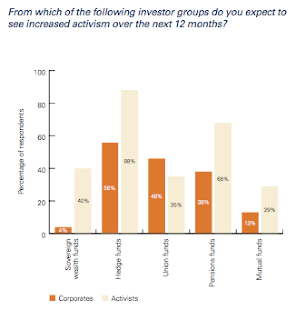Esteemed corporate law firm Wachtell Lipton recently published "Some Thoughts for Boards of Directors in 2011" to highlight the key issues companies must address in the upcoming year. In 2011, companies will have greater difficulty in implementing corporate governance "best practices" that are geared toward building long-term shareholder value particularly due to, WLRK argues, "one-size-fits-all" regulation and increased shareholder activism. Among the latest concerns are: "pending rules regarding proxy access, say-on-pay, enhanced SEC disclosure requirements, compensation clawbacks, board structure", and so forth. WLRK addresses the following in the report:
Proxy Access
Although proxy access is currently stayed (with the case expected to be resolved by late spring 2011), companies are still vulnerable to activists "pursu[ing] shareholder proposals and bylaw amendments to impose proxy access on a company-by-company basis" regardless of the ruling.
WLRK provide a detailed approach to handling proxy access here. They recommend that companies engage discussions with major shareholders, particularly those who have owned 3% of the company continuously for at least 3 years and are now eligible to use proxy access. Firms should proactively monitor their shareholder bases well before any Schedule 14N filing. In addition, firms should take note of the fact that shareholders can "aggregate their holdings in order to meet the 3% minimum ownership threshold". At the same time, companies must be wary of that any communications concerning director nomination will result in the nomination not counting toward the 25% cap. Other considerations involve revising bylaws, director qualifications, board size and dynamics, etc.
In the event that a director is elected by a shareholder initiative under proxy access, "boards will need to work to minimize the potential for adverse effects on board stability, collegiality and effectiveness".
Executive Compensation
New SEC regulations and Dodd-Frank provisions have opened a floodgate of new executive compensation issues for companies.
- Companies holding a shareholder annual meeting on January 21, 2011 or later will need to have a "non-binding say-on-pay resolution seeking shareholder approval of named executive officer compensation", as well as a resolution on how often the say-on-pay vote will occur. WLRK argues that holding the say-on-pay vote once every three years more properly aligns the initiative with long-term goals. With that said, many proxy advisory firms have recommended an annual say-on-pay vote.
- Companies will need to disclose "golden parachute" plans via tender offer materials and merger proxy statements, in addition to seeking a non-binding vote on the matter.
- Companies will need to disclose information concerning executive compensation and its relationship to company performance in their proxy statements. Disclosure on stock hedging will be required, as well.
- Companies will need to disclose "the ratio of the median annual total compensation of the company's employees (excluding its CEO) to the annual total compensation of its CEO". This could entail "substantial administrative costs".
- Companies will need to disclose incentive-based compensation and follow newly expanded compensation clawback requirements.
In light of the regulatory and public focus on executive compensation, companies will need to focus on discouraging short-term risk-taking and be careful of allocating so-called "excessive" pay packages, while retaining talented long-term-minded executives.
Risk Management
Recent unfortunate events, like the Gulf of Mexico oil spill and Toyota product recalls, have revealed, and furthered, the importance of proper risk management. New regulation has also sought to establish greater transparency in companies risk management practices.
- "[B]ank holding companies with total assets of $10 billion or more, as well as certain other non-bank financial companies" will be required "to have a separate risk committee which includes at least on risk management expert with experience managing risk at large companies".
- The Federal Reserve Board might require smaller bank holding companies to take similar measures to the one described above.
- Required discussion of board risk oversight and leadership in proxy statements and annual reports.
- Companies must describe how compensation aligns with proper risk management.
Wachtell Lipton advises that directors not involve themselves in risk management on a day-to-day basis. Instead, directors should ensure "that the risk management policies and procedures… are consistent with the company's corporate strategy and risk appetite, that [they] are functioning as directed, and that necessary steps are taken to foster a culture of risk-aware and risk-adjusted decision-making throughout the organization". The CEO and senior executives should be the ones "fully engaged in risk management".
To read more, click here.
Board Composition and Director Qualifications
Wachtell Lipton recommends that companies find a "well-rounded board"--a task, the firm argues, that is being challenged by proxy advisor, regulator, and shareholder activist requests for independent directors. The law firm further states, "one of the 'lessons learned' from the financial crisis is that the tremendous complexity of the businesses and risks facing financial institutions warranted more industry expertise and insider knowledge in their boardrooms." Companies must seek to strike a happy medium between independence and insider knowledge in their boards. This is no easy task due to the nature of those with industry expertise having affiliations with other knowledgeable executives in the field. The NYSE's Commission on Corporate Governance only partially recognizes this when they state, "a properly functioning board can include one non-independent director". Wachtell Lipton argues that "there should be no complaint about adding additional inside directors to a board so long as a majority of the board consists of 'independent' directors".
Click here, to read "Some Thoughts for Boards of Directors in 2011".
Posted by David Schatz

























